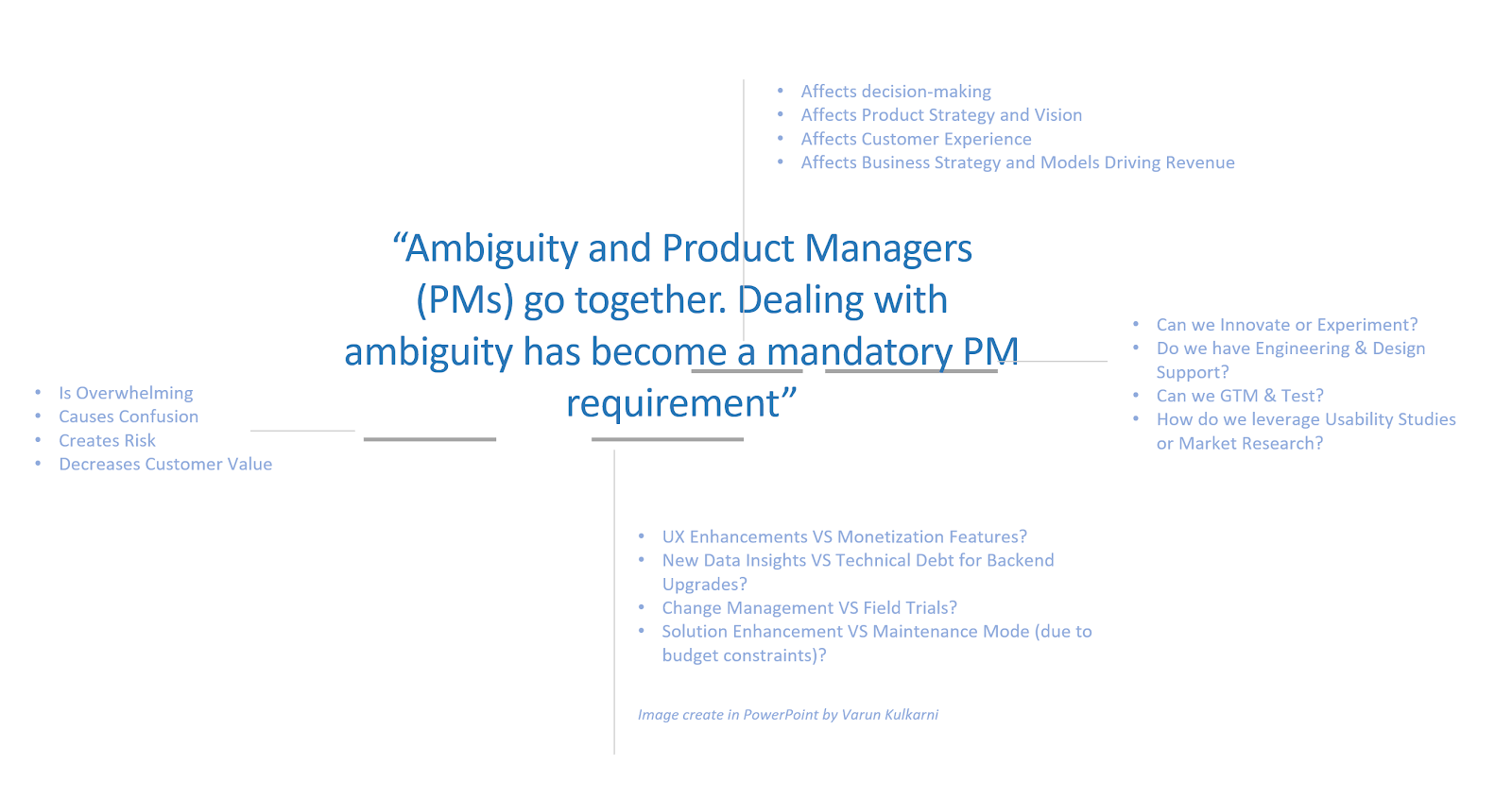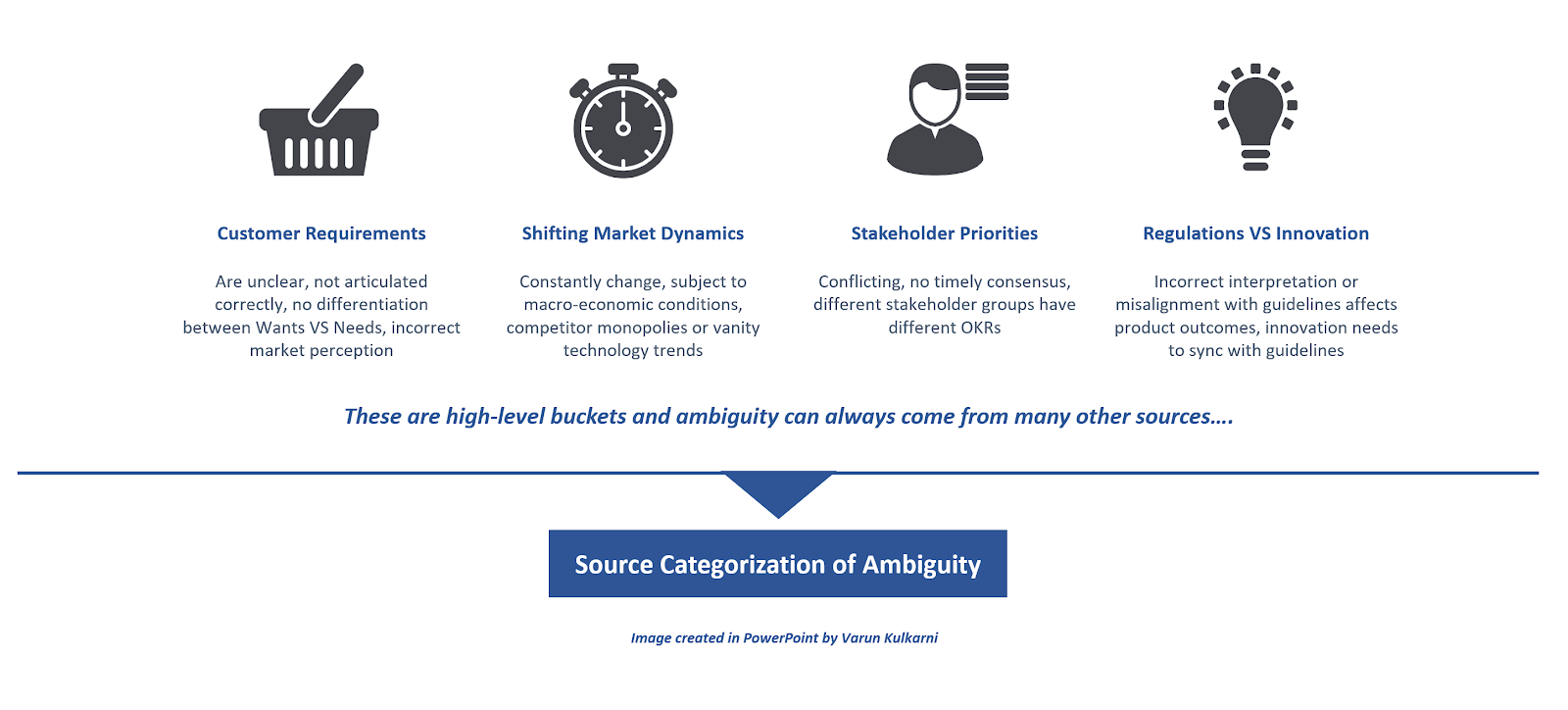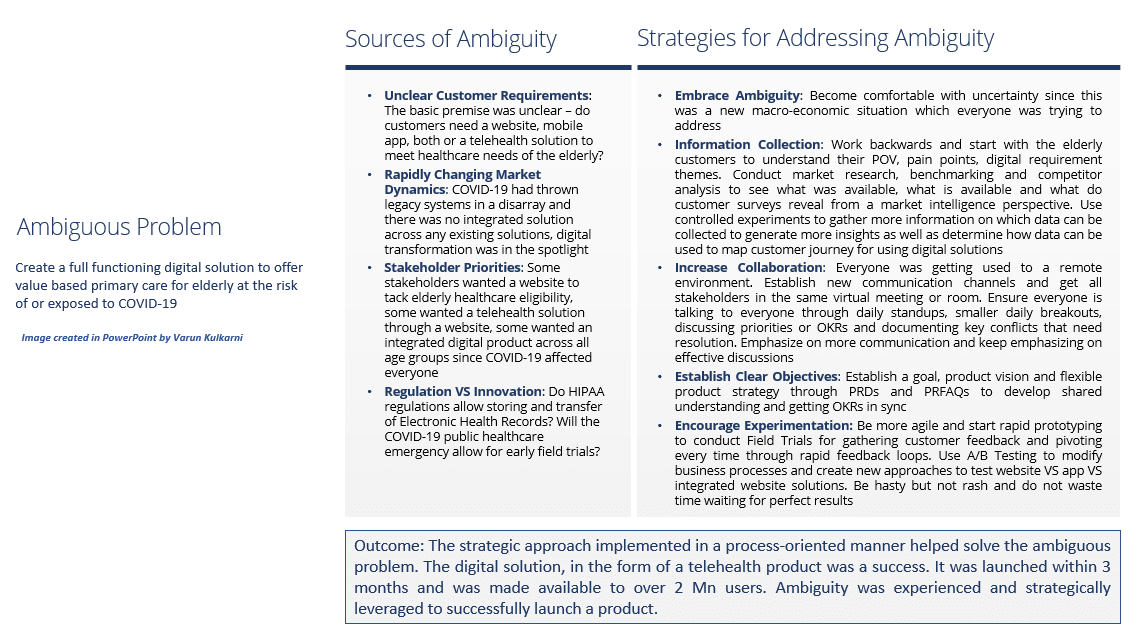

Dealing with ambiguity as aproduct manager - Mind the Product
source link: https://www.mindtheproduct.com/ambiguity-as-product-managers/
Go to the source link to view the article. You can view the picture content, updated content and better typesetting reading experience. If the link is broken, please click the button below to view the snapshot at that time.
Dealing with ambiguity as aproduct manager
BY Varun Kulkarni ON MARCH 14, 2023
Based on his personal experience as a product manager for 6 years and work done at Deloitte Consulting and Cisco Webex, Senior Product Manager Varun Kulkarni explains how to deal with ambiguity as a product manager.
Product managers mostly, if only sometimes, have to deal with ambiguity. Whether it is unclear customer requirements, conflicting priorities, rapidly shifting market dynamics, designing innovative solutions, or any day-to-day activity, product managers must overcome obscurity/vagueness or cryptic challenges that create ambiguous directives. A simple example is Cool Customer-Centric Features VS Monetization Features VS Technical Debt. Ambiguity (in the absence of data) affects decision-making, product strategy, vision, and simply shipping new features or products.

Figure 1: Ambiguity Aspects
Over the last six years as a product manager launching digital products across the technology, healthcare, and e-commerce sectors, I have faced many ambiguous scenarios. Some of them also required to be addressed within tight deadlines. I frequently have peers, mentees, and supervisors (yes, supervisors!) reach out and complain that they are overwhelmed with ambiguity and do not see a straightforward approach that entails positive outcomes. In such circumstances, product managers need to take charge and learn how to deal with and leverage ambiguity for optimal results.
So how can a product manager effectively deal with ambiguity? In this article, I share a simple 2 step process refined across many ambiguous scenarios I had to address as a product manager over six years – try to understand the sources of ambiguity and adopt flexible strategies to reduce them. Ambiguity is inevitable (like Thanos), it can’t be taken away, but its extent can be reduced.
Sources of ambiguity
First, I will discuss how to pinpoint the sources of ambiguity for categorization.

Figure 2: Ambiguity Sources
Customer requirements: A product manager ultimately needs to ship what the customer wants and that which will increase customer value. Understanding customer needs and requirements can be challenging, especially when customers cannot articulate their needs clearly or have conflicting demands, which is usually the primary source of ambiguity.
Shifting market dynamics: Markets are constantly changing. Trends, technologies, competition, or other macroeconomic conditions add to obscurity. This further leads to changes in what the customer wants VS needs based on their market perception.
Stakeholder priorities: Conflicting priorities add to the ambiguity faced by PMs, especially when reaching a consensus is always an issue. Stakeholder groups with different OKRs never aligned for a common product goal.
Regulations VS Innovation: Regulatory changes and innovation strategy must be aligned correctly to avoid ambiguity, mainly if strategic leadership interprets guidelines differently.
There will always be more sources and different avenues of ambiguity – but they can all be categorized in the above buckets to define, design, and implement a streamlined approach for resolution.
Strategies to deal with ambiguity
Once ambiguity sources are categorized, a product manager must design or adopt flexible strategies to deal with them. Remember, you are expected to work cross-functionally, which is a tool to improve any associated product strategy.

Figure 3: Strategies for Dealing with Ambiguity
Embrace ambiguity: Sounds obvious, and it is! As a product manager, you should be comfortable working in an environment where things could be unclear and proactively seeking information to help reduce ambiguity.
Information Collection: Gathering the correct information or data timely is necessary to understand customer requirements better, identify trends or patterns to distinguish better customer wants VS needs, discern market trends, and reveal stakeholder priorities. Conducting market research, customer surveys, and other forms of market intelligence (A/B testing, randomized test groups, controlled experiments, etc.) can help product managers better understand customer needs, market trends, and stakeholder priorities. Identify customer pain points, narrow them down for focused impact, and leverage team strength.
Intensify Degree of Collaboration: The more the collaboration, the more the PM syncs with different aspects of ambiguity and sources. Consistent and intense cooperation with stakeholders, including customers, partners, and team members, builds consensus, resolves some, if not all, conflicts, and highlights priorities. Directed and pre-defined workshops and meetings are always a good starting point for such collaboration.
Establish Clear Objectives: Try to establish clear and measurable objectives. As product managers put forward a vision of shared understanding of what the product should achieve and what success looks like. PRFAQs, whitepapers, OKRs, and product roadmaps should play an integral role in creating this sync driven by flexible product strategy and vision.
Encourage Experimentation or Out-Of-The-Box Thinking: Product managers should leverage experimentation and risk-taking to deal with ambiguity. Early Field Trials, Beta Tests, or Pilot Releases with new product features, business models, and customer engagement strategies, even in tight deadlines, are insightful approaches to see what works best for the target market. However, no rash decision-making, and more importantly, do not waste time or resources by trying to be a perfectionist!
Again, there will be many strategies (using data helps!), business flows, or operational decisions that can reduce ambiguity. But the above buckets are essential for viable solutions. They are an inherent framework for differentiating product offerings to capture the maximum possible customer value.
To provide practical context, see below for a very high-level use-case of how I used the above 2-step process to address a high-stakes ambiguous product launch during the initial testing times of COVID-19.
A real-life use case for dealing with ambiguity as a product manager
Ambiguous problem: Create a full-functioning digital solution to offer value-based primary care for the elderly at risk of or exposed to COVID-19 (literally what I was asked to build and without any additional details within six months). The below image describes how I identified sources of ambiguity and leveraged strategies to deal with them, allowing for a product launch within three months.

Figure 4: Use Case for Dealing with and Leveraging Ambiguity
How to deal with failure?
All this is great, but what happens if I, as the product manager, fail and do not deliver measurable results?
Take responsibility: Accountability goes a long way to show that you can face and handle challenges. Use lessons learned to reflect, retrospect, and review your actions, decisions, and any available metrics. Try again by reiterating and refining your approach. Keep experimenting and ensure accountability across stakeholders.
Get comfortable and be calm:
- Do not make hasty decisions or wait for perfect results
- Ensure there are transparent communication channels across stakeholders to maintain deliverable progress
- Get feedback from peers, supervisors, and others to identify gaps and business strategies to drive optimal operational processes
Finally, next time you have to deal with ambiguity, try the above 2-step process and keep reiterating till it makes your work as a product manager operationally efficient.
Discover more great content on Mind the Product
Recommend
About Joyk
Aggregate valuable and interesting links.
Joyk means Joy of geeK
